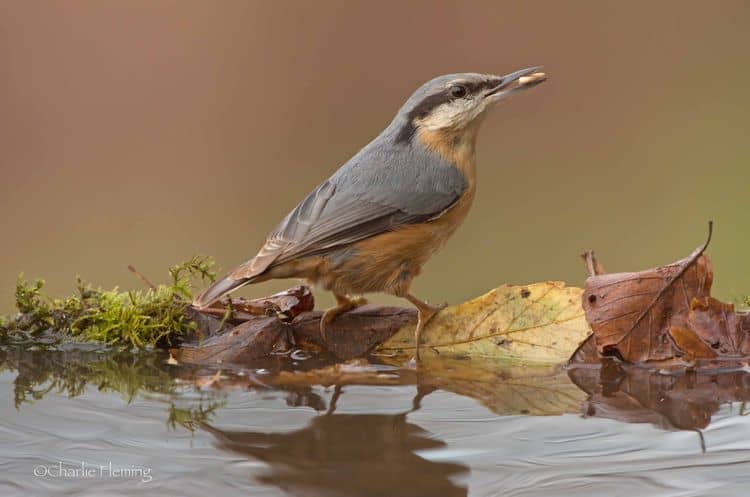There will be more of these reflected shots to come but probably not today. I am “house-bound” due to the appalling weather and also lack of transport but I have had a nice week and a very successful one as well.
I prefer cold bright frosty days, much better for bird watching and photography.
Yesterday continued to be just as interesting at the hide, I was hoping to see Bramblings on the feed but as yet thats not hapened. I was hoping to see and photograph the Shrew seen the day before but there was no sign today.
The Jays are now almost constantly with me feeding, as well as on peanuts but also on the scattered seed that I have spread on the ground for the Bramblings …… fingers crossed!
Interesting and worth noting that they are moving around in a pair which would indicate to me that they a not only monogomous but pair for life. This would appear to be a good strategy.
It means that not only do they gain some advantage from moving around together as a pair, two pairs of eyes being better than one both in relation to finding food and watching for predators but it means that energy and time is not wasted in the spring finding a mate and establishing a pair bond.
I am yet to establish wheather the female also immitates like the male.
It is possible to seperate the sexes when they are side by side by subtle differences in the head size and beak shape. I think that this individual is a male because I recognise the slight hook on the tip of the beak. It is of note that both birds during the breeding season regularly took day old chicks probably to feed their nestlings but at this time of year they don’t seem so keen, prefering nuts and seeds.
Nuthatches are probably the most common birds at the feeding station with at least 5 individuals coming constantly to the food. They do not display too much aggressive behaviour but it has been noticeable in the last few days and as the weather has become colder, aggression has increased particularly by the obvious males.
My guess is that this is a female, it has a slender beak and the flanks do not show strong brick red markings that you probably see in a male. (Check the markings on the photo above).
This is a Great Tit – Parus major
I mentioned that the Jays were moving around in pairs and as well as that there is a resident “true pair” of Blackbirds but interestingly also a pair of Robins. Robins are known to be extremely teritorial and a male will drive another from it’s territory, therefore seeing two birds in close proximity would indicate that a pair bond has already developed. Interestingly one of the Robins joined me in the hide and was just a few inches from me.
Male and female Robins are identical but I suspect that this is a female because I have not once heard Robin song at the hide.
Charles Fleming
Charles Fleming is a wildlife photographer and nature blogger based in South West England. His blog "Wildlife in a Suburban Garden" has more than 1400 entries and a link to his galleries where you can view more than 4000 images from home and abroad, including a gallery of birds of the world featuring photographs of more than 500 species. "My aim is to try and put my readers and viewers intimately close to the subject and to share the thrill of watching and photographing birds and wildlife at close quarters".
- Web |
- More Posts(17)

Leave a Reply